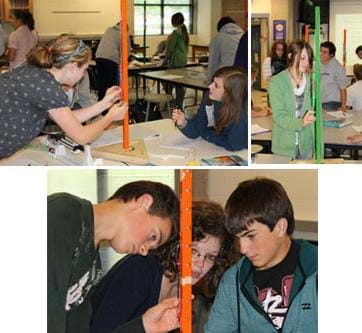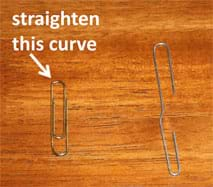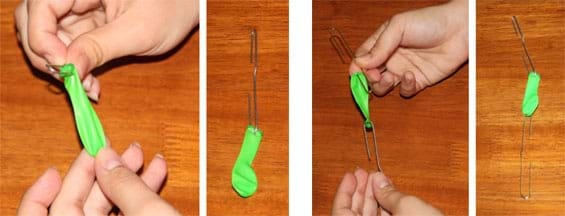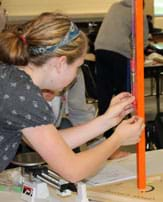Quick Look
Grade Level: 11 (10-12)
Time Required: 30 minutes
Expendable Cost/Group: US $0.30 In addition, the activity requires the use of some non-expendable items commonly found in school classrooms and labs; see the Materials List for details.
Group Size: 3
Activity Dependency:
Subject Areas: Biology, Data Analysis and Probability, Physical Science, Reasoning and Proof
NGSS Performance Expectations:

| HS-PS2-6 |

Summary
Students use balloons (a polymer) to explore preconditioning—a viscoelastic material behavior that is important to understand when designing biomedical devices. They improve their understanding of preconditioning by measuring the force needed to stretch a balloon to the same displacement multiple times. Students gain experience in data collection and graph interpretation.Engineering Connection
Bioengineers study biological materials and how they function in healthy and diseased states. Since biological materials possess viscoelastic behavior, engineers must understand this behavior in order to fully characterize these materials. Engineers may also design devices that come into contact with biological materials. So, to ensure effective and successful device performance, engineers must understand how the biological environment reacts to the forces that a device imposes. Polymers such as balloons also exhibit viscoelastic behavior and can be used to demonstrate and understand how biological materials function.
Learning Objectives
After this activity, students should be able to:
- Describe preconditioning using balloons. Specifically, students should be able to explain what is happening to polymers (on a molecular-level) during preconditioning.
- Graph collected data using Microsoft Excel.
- Calculate percent difference between two values.
- Identify points of equilibrium on a graph.
- Explain sources of error in experimental data.
- Communicate reasons or examples that understanding preconditioning of viscoelastic materials is important for engineering design.
Educational Standards
Each TeachEngineering lesson or activity is correlated to one or more K-12 science,
technology, engineering or math (STEM) educational standards.
All 100,000+ K-12 STEM standards covered in TeachEngineering are collected, maintained and packaged by the Achievement Standards Network (ASN),
a project of D2L (www.achievementstandards.org).
In the ASN, standards are hierarchically structured: first by source; e.g., by state; within source by type; e.g., science or mathematics;
within type by subtype, then by grade, etc.
Each TeachEngineering lesson or activity is correlated to one or more K-12 science, technology, engineering or math (STEM) educational standards.
All 100,000+ K-12 STEM standards covered in TeachEngineering are collected, maintained and packaged by the Achievement Standards Network (ASN), a project of D2L (www.achievementstandards.org).
In the ASN, standards are hierarchically structured: first by source; e.g., by state; within source by type; e.g., science or mathematics; within type by subtype, then by grade, etc.
NGSS: Next Generation Science Standards - Science
| NGSS Performance Expectation | ||
|---|---|---|
|
HS-PS2-6. Communicate scientific and technical information about why the molecular-level structure is important in the functioning of designed materials. (Grades 9 - 12) Do you agree with this alignment? |
||
| Click to view other curriculum aligned to this Performance Expectation | ||
| This activity focuses on the following Three Dimensional Learning aspects of NGSS: | ||
| Science & Engineering Practices | Disciplinary Core Ideas | Crosscutting Concepts |
| Communicate scientific and technical information (e.g. about the process of development and the design and performance of a proposed process or system) in multiple formats (including orally, graphically, textually, and mathematically). Alignment agreement: | Attraction and repulsion between electric charges at the atomic scale explain the structure, properties, and transformations of matter, as well as the contact forces between material objects. Alignment agreement: | Investigating or designing new systems or structures requires a detailed examination of the properties of different materials, the structures of different components, and connections of components to reveal its function and/or solve a problem. Alignment agreement: |
Common Core State Standards - Math
-
Understand that the graph of an equation in two variables is the set of all its solutions plotted in the coordinate plane, often forming a curve (which could be a line).
(Grades
9 -
12)
More Details
Do you agree with this alignment?
-
Represent data on two quantitative variables on a scatter plot, and describe how the variables are related.
(Grades
9 -
12)
More Details
Do you agree with this alignment?
-
Solve simple rational and radical equations in one variable, and give examples showing how extraneous solutions may arise.
(Grades
9 -
12)
More Details
Do you agree with this alignment?
International Technology and Engineering Educators Association - Technology
-
Explain how knowledge gained from other content areas affects the development of technological products and systems.
(Grades
6 -
8)
More Details
Do you agree with this alignment?
State Standards
Colorado - Math
-
Summarize, represent, and interpret data on a single count or measurement variable.
(Grades
9 -
12)
More Details
Do you agree with this alignment?
-
Solve linear equations and inequalities in one variable, including equations with coefficients represented by letters.
(Grades
9 -
12)
More Details
Do you agree with this alignment?
Colorado - Science
-
Matter has definite structure that determines characteristic physical and chemical properties
(Grades
9 -
12)
More Details
Do you agree with this alignment?
Materials List
Each group needs:
- ring stand
- ring stand attachment, from which to hang the paper clips, balloon and spring scale, (for example, 3-inch diameter ring support for $5.20 at Home Training Tools)
- 2 large wire paper clips
- 1 water balloon (for example, 50 Water Balloon Bombs for $1.75 at Amazon.com)
- spring scale with 5 Newton capacity (for example, Tubular Spring Scale 500g/5N for $5 at Amazon.com)
- 1 measuring ruler (with metric units)
- computer with Microsoft Excel or similar software application
- Preconditioning Balloons Data Analysis Worksheet, one per person
To share with the entire class:
- roll of masking or scotch tape, to adhere ruler to ring stand (each group needs two, 2-inch pieces)
- (optional) computer and projector to show the Preconditioning Balloons Lab Steps PowerPoint file
Worksheets and Attachments
Visit [www.teachengineering.org/activities/view/cub_surg_lesson04_activity2] to print or download.Pre-Req Knowledge
An understanding of algebra and how to solve algebraic equations, the ability to create graphs using Microsoft Excel, and an understanding of the content presented in the Viscoelasticity lesson.
Introduction/Motivation
When attempting to inflate a balloon, what is the first thing you learn to do to make it easier? (Listen to student ideas.) That's right—you stretch it multiple times! Many people do this because they know it works, but few understand why it works.
Today we will stretch balloons multiple times and measure the force required to stretch the balloon to observe a phenomenon known as preconditioning.
For our ongoing bioengineering design project, we need to understand how the materials in our bodies behave in response to forces so that we can design devices that will not harm the body. This activity introduces the intriguing behavior of viscoelastic materials, including biological materials.
Procedure
(optional: To guide students through the activity, use a projector to display the three slides of the Preconditioning Balloons Lab Steps PowerPoint in the classroom.)
Background
As described in the Viscoelasticity lesson, viscoelastic materials, such as balloons, demonstrate some very different responses to forces that depend on time and what has been done to the material in the past. These materials seem to have a "memory."
One type of behavior we discussed was preconditioning. A unique property of this behavior is that the force required to stretch the viscoelastic material to a certain displacement decreases with increased cycles of loading and unloading (until equilibrium is reached). The viscoelastic material, in this case a balloon, then "remembers" that this cyclic loading was performed on it such that when you inflate the balloon, it requires less force to stretch it to that displacement.
Recall our discussion about polymers. Balloons are made up of polymers. Knowing what you know about polymers from the viscoelasticitiy lesson, what do you think is happening on a molecular level to allow this to happen? (Listen to student ideas).
Let's think about the structure of polymers at an even more microscopic level. Imagine you have a string and a rubber band that are the same length. What happens when you pull on both ends of the rubber band? (It stretches). What happens when you pull on both ends of the string? (It doesn't stretch). Imagine you begin to twist both ends of the string in opposite directions, causing the string length to shrink and the string to kink. But now, what happens with the pull on both ends of the kinked string? (It stretches apart and shrinks back together just like the rubber band!) This is because rubber bands are made up of kinked polymers, which is what gives it the ability to stretch.
But this doesn't entirely answer the question of what is happening during preconditioning at a molecular level. If a balloon is made up of lots of kinked polymers that are overlaying each other, why might preconditioning stretch out the balloon? What is stretching the balloon doing to the kinked polymers? (Listen to student ideas). On a molecular-level, prior to preconditioning, the kinks are twisted on top of one another. Preconditioning relaxes and unkinks the polymers.
In today's activity we will observe quantitatively that preconditioning is taking place in the balloon. To observe this, we need to know how the force is changing when we stretch the balloon to the same displacement multiple times, so we will record and graph the force and the cycle number.
Before the Activity

- Gather materials and make copies of the Preconditioning Balloons Data Analysis Worksheet.
- Prepare for each group a ring stand with the attachment piece clamped near the top of the ring stand.
- Prepare the balloons and paper clips for each group by following these steps:
- Straighten one curve of a wire paper clip, as shown in Figure 1. This opens up the paperclip so it has two hooks at opposite ends. Repeat this process for a second paper clip.
- Using the metal hook of one opened-up paper clip, puncture the top of an un-inflated balloon. Then feed the paper clip through the hole, as shown in Figure 2.
- Using the wire hook of the second opened-up paper clip, puncture the bottom of the balloon and feed the hook through the hole, as shown in Figure 3.
- Repeat this process to prepare enough for one balloon with two attached paper clips per group.
- Divide the class into groups of three or four students each and assign roles (see Troubleshooting Tips section).

Figure 2 (left). Attach one paper clip to one end of a balloon. Figure 3 (right). Attach the second paper clip to the other end of the balloon.
With the Students

- Have each group collect its set of supplies: a balloon with two attached paper clips, ring stand with attachment, spring scale, measuring ruler and 2 pieces of tape, each approximately 2 inches long. Remind students not to stretch the balloons at all (see the Troubleshooting Tips section).
- Attach one end of the balloon to the ring stand using the paper clip as a hook.
- Tape the ruler to the ring stand so that the "0 cm" reading is aligned with the top hole of the balloon.
- Attach the spring scale to the other end of the balloon using the lower paper clip as a hook. Get ready to record.
- Stretch the balloon until the bottom hole of the balloon is at 10 cm.
- Immediately record the force at this displacement and slowly release the spring scale to remove the force from the balloon.
- Repeat steps 5 and 6 nine times so that force data is collected from a total of 10 cycles.
- As a class, discuss the potential for error in data sets, as described in the Assessment section. Compare results and share observations and conclusions.
- Conclude by having students complete and turn in the worksheet, which includes graphing in Excel and answering questions.
Vocabulary/Definitions
loading: Applying a force.
polymer: A material composed of a compound that is repeated to form a chain. Common examples are plastics and rubbers.
preconditioning: When a viscoelastic material is exposed to multiple loading and unloading cycles, the force required to stretch the material and the energy lost in a cycle decreases with increased cycles until equilibrium is reached.
stress relaxation: The response of a viscoelastic material when a constant displacement is applied. The force required to hold the material at that displacement decreases over time until equilibrium is reached.
unloading: Removing an applied force.
viscoelastic: A characteristic of materials that exhibit both viscous and elastic properties when undergoing deformation.
Assessment
Pre-Activity Assessment
Reflection & Prediction: Encourage students to reflect on what they learned during the Viscoelasticity lesson and predict whether the force will change with repeated cycles or not. If they think the force will change, will it increase or decrease? Have students record their hypotheses and sketch their predictions of what they think the force (y-axis) vs. cycle number (x-axis) graph will look like.
Activity Embedded Assessment
Discussion: After completing data collection, have students discuss what variables could introduce error into their data sets. Possible examples: not pulling the balloon to the exact same displacement every cycle, reading the incorrect force on the spring scale, not reading the force on the spring scale fast enough (before stress relaxation begins), etc.
Post-Activity Assessment
Worksheet & Graphing: Have students complete the Preconditioning Balloons Data Analysis Worksheet. This requires that they plot their data to make a graph in Excel, and answer questions about the data and graph. Review their answers to gauge their mastery of the subject matter.
Troubleshooting Tips
Prepare a few extra balloons with attached paper clips before the start of the activity. Although uncommon, occasionally a balloon breaks and a team would need another one.
This activity works best when team jobs are assigned to students at the beginning of the activity and NOT varied throughout the activity. Suggested team roles: 1) pulling the balloon to 10 cm; 2) reading the force measurement; 3) recording data; 4) set-up and clean-up (if teams of three, have everyone contribute to this last job).
This activity is sensitive to human variability and error! Alert students to:
- (Before the activity) Handle the balloons carefully! If students stretch the balloons before they are used in the activity, then they are unknowingly preconditioning them so that those balloons will not show a difference in force with repeated cycles when being stretched during the activity.
- (During the lab) Be careful to stretch the balloon to the same displacement for every cycle, immediately recording the force and then releasing the force. If force is applied to the balloon and left there for a prolonged period of time, the force at that displacement will decrease (stress relaxation).
If a team makes a mistake during the activity, students can repeat the activity with the same balloon but at a larger displacement (for example, 15 cm instead of 10 cm). The preconditioning effect can be observed at any displacement that the balloon has not been previously exposed to. Thus, students can observe the difference in force at a larger displacement, but not a smaller one.
Activity Extensions
- The decrease in force due to preconditioning can be observed at any displacement at which the balloon has not been previously exposed. Thus, this activity can be repeated at multiple displacements as long as students start at the lowest displacement and increase the displacement after the 10 cycles. For example, students could stretch the balloon to 5 cm and record the force for 10 cycles, and then repeat at 10 cm displacement for 10 cycles, then repeat at 15 cm displacement for 10 cycles, etc. Ask the students: What are advantages of taking more data?
- Test the effectiveness of casual (unknowing) preconditioning by the average person blowing up balloons. Have a student hand stretch a balloon as if s/he were going to blow it up. Then use that balloon to conduct the force testing procedure (same as in the regular lab). Compare the data and graphs.
- Have students reflect on what they have learned about polymers and preconditioning by writing a paragraph explaining the importance that engineers, in multiple fields, understand the ability of polymers to be preconditioned. They can choose from one of the following engineering professions and explain why this knowledge is important:
- Structural engineering – why is it important that engineers designing bridges and buildings, maintain an understanding the viscoelastic behavior of polymers?
- Biomedical engineering – why is it important that engineers designing devices that will operate in conjunction with biopolymers (such as human tissue), maintain an understanding the viscoelastic behavior of polymers?
- Aerospace engineering – why is it important that engineers designing aircrafts, spacecraft and rockets, all of which are built using synthetic polymers, maintain an understanding of the viscoelastic behavior of polymers?
If there is access to laptops or a computer lab, students could pick one of the three options, research ideas, and write their paragraph. Without research, they could just brainstorm ideas.
Subscribe
Get the inside scoop on all things TeachEngineering such as new site features, curriculum updates, video releases, and more by signing up for our newsletter!More Curriculum Like This

Students are introduced to the concept of viscoelasticity and some of the material behaviors of viscoelastic materials, including strain rate dependence, stress relaxation, creep, hysteresis and preconditioning. Viscoelastic material behavior is compared to elastic solids and viscous fluids.

Students learn about viscoelastic material behavior, such as strain rate dependence and creep, by using silly putty, an easy-to-make polymer material. They learn how to make silly putty, observe its behavior with different strain rates, and then measure the creep time of different formulations of si...

Students learn why engineers must understand tissue mechanics in order to design devices that will be implanted or used inside bodies, to study pathologies of tissues and how this alters tissue function, and to design prosthetics. Students learn about collagen, elastin and proteoglycans and their ro...

Students calculate stress, strain and modulus of elasticity, and learn about the typical engineering stress-strain diagram (graph) of an elastic material.
Copyright
© 2011 by Regents of the University of Colorado.Contributors
Brandi N. Briggs; Marissa ForbesSupporting Program
Integrated Teaching and Learning Program, College of Engineering, University of Colorado BoulderAcknowledgements
The contents of these digital library curricula were developed by the Integrated Teaching and Learning Program under National Science Foundation GK-12 grant no. 0338326. However, these contents do not necessarily represent the policies of the National Science Foundation, and you should not assume endorsement by the federal government.
Last modified: February 25, 2020









User Comments & Tips